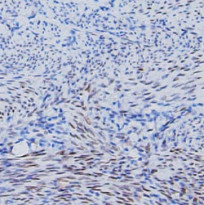ARG44660
anti-FGF basic antibody
anti-FGF basic antibody for ELISA,IHC-Formalin-fixed paraffin-embedded sections,Immunoprecipitation,Western blot and Human
Overview
| Product Description | Mouse Monoclonal antibody recognizes FGF basic |
|---|---|
| Tested Reactivity | Hu |
| Tested Application | ELISA, IHC-P, IP, WB |
| Host | Mouse |
| Clonality | Monoclonal |
| Isotype | IgG1 |
| Target Name | FGF basic |
| Antigen Species | Human |
| Conjugation | Un-conjugated |
| Alternate Names | FGF2; Fibroblast Growth Factor 2; FGFB; Fibroblast Growth Factor 2 (Basic); Heparin-Binding Growth Factor 2; HBGF-2; FGF-2; BFGF; Basic Fibroblast Growth Factor BFGF; Basic Fibroblast Growth Factor; Prostatropin |
Application Instructions
| Application Suggestion |
|
||||||||||
|---|---|---|---|---|---|---|---|---|---|---|---|
| Application Note | * The dilutions indicate recommended starting dilutions and the optimal dilutions or concentrations should be determined by the scientist. |
Properties
| Form | Liquid |
|---|---|
| Purification | Protein A purification |
| Buffer | PBS with 0.09% sodium azide |
| Storage Instruction | For continuous use, store undiluted antibody at 2-8°C for up to a week. For long-term storage, aliquot and store at -20°C or below. Storage in frost free freezers is not recommended. Avoid repeated freeze/thaw cycles. Suggest spin the vial prior to opening. The antibody solution should be gently mixed before use. |
| Note | For laboratory research only, not for drug, diagnostic or other use. |
Bioinformation
| Database Links | |
|---|---|
| Gene Symbol | FGF2 |
| Gene Full Name | Fibroblast Growth Factor 2 |
| Background | The protein encoded by this gene is a member of the fibroblast growth factor (FGF) family. FGF family members bind heparin and possess broad mitogenic and angiogenic activities. This protein has been implicated in diverse biological processes, such as limb and nervous system development, wound healing, and tumor growth. The mRNA for this gene contains multiple polyadenylation sites, and is alternatively translated from non-AUG (CUG) and AUG initiation codons, resulting in five different isoforms with distinct properties. The CUG-initiated isoforms are localized in the nucleus and are responsible for the intracrine effect, whereas, the AUG-initiated form is mostly cytosolic and is responsible for the paracrine and autocrine effects of this FGF. [provided by RefSeq, Jul 2008] |
| Function | Plays an important role in the regulation of cell survival, cell division, cell differentiation and cell migration. Mediates phosphorylation of ERK1/2 and thereby promotes retinal lens fiber differentiation. [UniProt] |
| Cellular Localization | Nucleus, Secreted. [UniProt] |
| Calculated MW | 31 kDa |
| PTM | Isopeptide bond, Methylation, Phosphoprotein, Ubl conjugation. [UniProt] |
Images (3) Click the Picture to Zoom In
-
ARG44660 anti-FGF basic antibody IHC-P image
Immunohistochemistry: Human Uterus stained with ARG44660 anti-FGF basic antibody at 2 µg/mL dilution.
-
ARG44660 anti-FGF basic antibody WB image
Western blot: SK-OV-3 stained with ARG44660 anti-FGF basic antibody at 1 µg/mL dilution.
-
ARG44660 anti-FGF basic antibody IP image
Immunoprecipitation: SK-OV-3 lysate immunoprecipitated with 2.5 µg of ARG44660 anti-FGF basic antibody.








